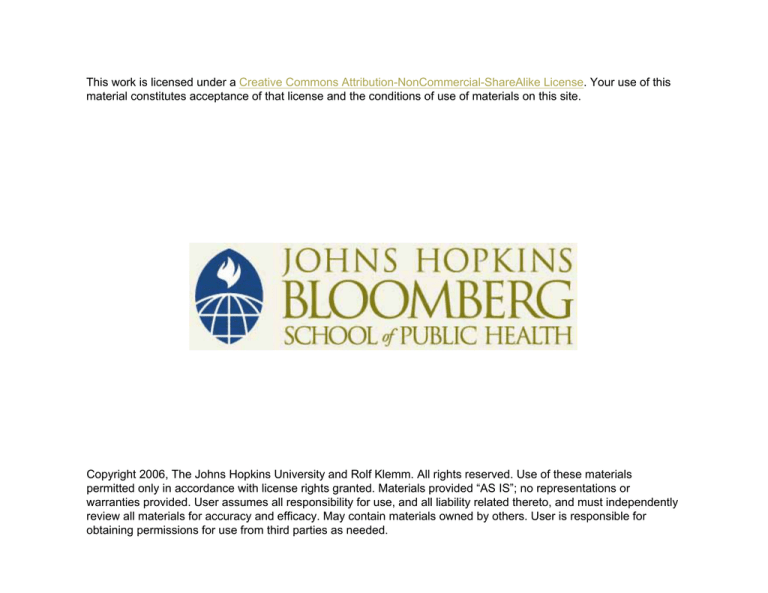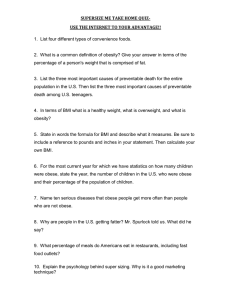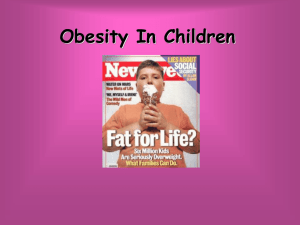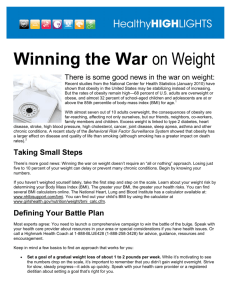
This work is licensed under a Creative Commons Attribution-NonCommercial-ShareAlike License. Your use of this
material constitutes acceptance of that license and the conditions of use of materials on this site.
Copyright 2006, The Johns Hopkins University and Rolf Klemm. All rights reserved. Use of these materials
permitted only in accordance with license rights granted. Materials provided “AS IS”; no representations or
warranties provided. User assumes all responsibility for use, and all liability related thereto, and must independently
review all materials for accuracy and efficacy. May contain materials owned by others. User is responsible for
obtaining permissions for use from third parties as needed.
US Food & Nutrition Policies:
Ideal vs. Reality:
US Food Industry, Agricultural Policy, Food
Availability, Consumer Demand & Impact on
Dietary Choices
Case Study-Obesity
Rolf D.W. Klemm, MPH, Dr PH
Johns Hopkins Bloomberg School of Public
Health
Outline: Obesity as a case study
Evidence-Obesity (5 W’s)
Context- agricultural, food industry, economic,
societal, biologic
Process
Policy Response
Impact
Need for a New Framework for Action
Food and Nutrition Policy Diamond
Evidence
Context
Policy
Content
Impact
Process
Policy Content depends on…
Evidence
Context
Process
Impact
Nutritional status, food availability, dietary
patterns, health outcomes; size, location &
conditions of risk groups
Type of food system, dietary culture,
strength of economy, government stability and
competence, private sector capabilities and
influence, transport structure, level of food aid
Political action, legislation, regulation, level of
enforcement, private sector cooperation, costs,
cost recovery mechanisms, competition,
non-nutritional priorities and concerns,
perceptions, surveillance capabilities, media
Nutritional status, diet intake & health outcomes;
economic impact (profit) across sectors,
agricultural and food industry effects, political
gains & losses
Evidence
besity
Obesity defined by BMI
BMI=Body Mass Index
Weight (kg)
Height (meters)2
BMI
Overweight
25-29.9
Moderately Obese
30.0-34.9
Severely Obese
35.0-39.9
Very Severely Obese ≥40.0
Relationship Between BMI and Percent
Body Fat in Women
Source: Adapted by CTLT from Gallagher et al, AJCN, 2000
Relationship between BMI and
Cardiovascular Disease Mortality
Source: Adapted by CTLT from Calle et al., NEJM, 1999
Adult Obesity
CDC 2005
Fully two-thirds of Americans are officially overweight, and about ½
of those (>61 million) have graduated to full-blown obesity
Prevalence of severe obesity (BMI≥40) quadrupled from 1/200 to
1/50 from 1986 to 2000
Prevalence of “super” obese (BMI≥50) increased 5x’s from 1/2000 to
1/400.
All groups becoming more obese. Lowest income
and least educated most overweight and obese
Adapted by CTLT. Obesity (BMI>30), based on BRFSS, 1990-2001 data, Strum, Rand Corp, 2003
Childhood Obesity
18
1971 to 1974
1988 to 1994
1999 to 2000
16
14
Percent
12
10
8
6
4
2
0
Boys
Girls
Children
Males
Females
Adolescents
In the past 30 years, the prevalence of overweight in the pediatric group has
tripled--~9 million children over 6 yrs of age are considered obese.
Obesity’s toll on human health
Significantly increases risk of:
Heart disease
High blood pressure
Stroke
Diabetes
Infertility
Gall-bladder disease
Osteoarthritis
Many forms of cancer
Medical cost of obesity-$75 billion/yr
$75 billion in 1998
Public pays ~$39 billion, or about $175/person thru
Medicare and Medicaid
Cover sicknesses associated with obesity including type 2
diabetes, cardiovascular disease, several types of cancer
and gallbladder disease
This does not include indirect costs related to lost
productivity, absenteeism
Finkelstein, et al. Obesity Research, 2004
So….what has caused the obesity epidemic?
Energy In
≠
Energy out
Choose your favorite…….
Sodas
Food
Pyramid
Fast
Food
Fat
No
sidewalks
“junk”
food
Elevators
Remote
Control
Stress
No
Parks
Parents
No
time
Large
portions
Thrifty
Ancestors
Carbs
Food
too
cheap
Cars
TV
Video
Games
Food too
expensive
School
lunch
The US public does not follow the Food
Guide Pyramid
Added
sugars & fats
Grains
USDA, Food Review, 2001
Context
Agriculture
Americans are eating more calories.
Calories: Total Food Supply and Food Supply Adjusted for Losses
3,800 cal/d
1,100 cal/d
losses
↑ 530
cal/d
ERS, USDA, 2000
90% of the caloric increase has come from
grains, added fats & oils and added sugars
Dairy & Eggs
-6.1
4.1
Meats and Nuts
>90%
6.1
Fruits & Vegetables
19.2
Added sugars
36.7
Added fats and oils
38.8
Grains
-10
0
10
20
30
40
Percent
ERS, Agricultural Fact Book, USDA
50
Where did all the extra
calories come from?
Agricultural Sector
Big Food, Big Money, Big People?
Agricultural
policies
subsidies, education,
research, marketing
assistance, farm credit,
commodity programs, trade
policies, rural infrastructure
↑ productivity
& efficiency
mechanization,
increased size of
farms, increased
specialization, fewer
farmers, less farm
labor, technological
innovations,
globalization
↑ food supply
↓food cost
↑ dependability
fierce competition,
low profits (3.5¢ per
dollar), heavy
subsidies as price
supports, vertical
integration, large
companies, focus on
“added value”, work
hard to create salesfriendly regulatory
environment,
Farm Subsidies
Shift from price supports backed by grain
reserves—which discouraged overproduction-- to
farm subsidies (direct payments to farmers) which
promotes overproduction
Gov’t spends ~$20 billion/yr
Big farmers get biggest subsidies
8 crops get subsidies: corn, soybeans, wheat,
cotton, rice; majority of farms such as fruit &
vegetable growers do not get a subsidy
Fewer farms, Larger Farms, Higher Productivity
ERS, USDA from Census of Agriculture
The Corn Connection
286 m tons/year
57% becomes inexpensive
animal feed—keeps meat
prices down, but also makes
meat fattier
5% refined to high-fructose
corn syrup (HFCS)-cheaper & sweeter than
sugar; easier transport &
mix into beverages,
spaghetti sauce, peanut
butter, etc.
Schizophrenic role of the USDA
Promote Agribusiness
Advise the Public about Diet and
Health
Context
Food Industry
Who is the Food Industry?
Refers to companies that produce, process,
manufacture, & serve foods, beverages & dietary
supplements (Girl scouts selling cookies to multi-billion
dollar corporations such as McDonalds & Monsanto)
Have enormous economic clout: generates ~$1 trillion
in annual sales; Accounts from 13% of GNP; Employs
17% of US labor force
Expend resources to develop & market products that
will sell, regardless of effect on nutritional status
Rapid consolidation has resulted in fewer but larger
companies with great ability to influence Americans
food purchases through their consolidated marketing
power
Food Industry
Abundant &
Cheap
Food Supply
Affluent
Society
Fierce Competition
Primary mission: Sell Products--Eat More
Advertise
Nutrition is a factor when it affects “bottom line”
Convince gov’t officials , Nutrition Professionals,
Media of Nutritional Value of Products
Are NOT Health or Social Service Organizations
Advertise, Advertise, Advertise
Direct Media Advertising
Expenditures, 1999
All Food & food
service companies $ 11 BILLION
McDonald’s
Burger King
Taco Bell
Coke & Diet Coke
Wrigley’s
M&M candies
$627 million
$403 million
$206 million
$174 million
$117 million
$ 80 million
USDA 5-A-day
$
3 million
Source: Nestle M, Food Politics, 2002
Supersizing-”better value”
Price
Relative
Size
$0.89
100%
42 oz “Super size” $1.59
250%
McDonalds
12 oz “Child size
Relative
Extra cost
79%
Munchies Kid’s Mix“Junk” food masquerading as health food?
Full page Ad from Wall Street Journal
“Mom and Dad, you’ll feel great about
offering it to your kids because Munchies
Kids Mix is a good source of 8 essential
vitamins and minerals, has 0 grams trans fat
and meets nutritional guidelines established
by [Texas fitness expert] Dr. Kenneth
Cooper for sugar, fat and sodium”
Munchies Kid’s Mix contains:
Cheetos, Doritos, Rold Gold pretzels,
SmartFood popcorn, Cap’n Crunch
cereal and M&M-like candy
FRENCH FRIES
20 Years
Ago
Today
210 Calories
2.4 ounces
610 Calories
6.9 ounces
Calorie Difference: 400 Calories
Maintaining a Healthy Weight is a
Balancing Act
Calories In = Calories Out
If you walk leisurely for 1 hour and 10 minutes
you will burn approximately 400 calories.*
*Based on 160-pound person
Mortal Mistakes?
Is Pleasantly
Plump OK?
Is Extra Heft
Helpful?
Source: Adapted by CTLT from Scientific American, June 2005
Context
Economic
High energy foods cost less; Low energy
foods cost more.
Grains, added sugars, and added fats
Among the lowest cost sources of dietary energy
Inexpensive, good tasting, & convenient
Highly promoted
More nutrient dense meats, fish, fresh vegetables,
and fruits
Generally cost more
Less convenient
Less promoted
Context
Societal
Societal Influences on Energy Intake
Poor Foods Available
Availability, low cost, sugars, fat, good taste
Food Industry
Packaging, advertising, size
“Pouring Rights” in schools
Channel One
Food Balance Sheet
Poor Foods
Healthy Foods
Highly accessible
Low accessibility
Convenience
Less convenient
Good-tasting
Worse tasting
Promoted heavily
Not promoted
Inexpensive
Expensive
Brownell, K, JHU Symposium, 2004
Eating Out
60
On a typical day,
40% of adults will
eat out at a
restaurant
Americans
spend $920 per
person on food
consumed away
from home
Out on home (%)
50
40
%
Restaurant
sales exceeded
$440 b in 2004
In home (%)
30
20
10
0
1990
1995
2000
2005
Tillotson J, Ann Rev Nutr, 2004
Societal Influences on Energy Expenditure
Labor-saving devices
Dangerous neighborhoods
Design of suburban neighborhoods
Decreased physical education in schools
Moving Too Little?
Percent of schools that require
physical education by grade, 2000
Source: Adapted by CTLT from Burgeson et al, 2001
Moving Too Little?
Moderate Physical Activity for Adults by Sex and Age
Total
Female
1997
Male
2002
18-24 years
25-44 years
2010
Target
45-64 years
65-74 years
75 years and over
0
10
20
30
40
Age-adjusted percent
National Health Interview Survey, NCHS, CDC.
50
Prevalence of Obesity by Hours of TV/Day
Why the Increase?
Multiple causes
Lifestyle, environment, and genes
Bottom line = ENERGY BALANCE (calories and physical activity)
More calories consumed
• Larger food portions and sizes
• Eating out more often
• Increases in soda, pizza, and candy consumption
Fewer calories being used up
• Declines in physically activity
• Increases in sedentary lifestyle and screen time
– Computers and television time
Process
Obesity Policies: “Stakeholders”
High SES
Middle Income
Poor
Consumers
Food
Manufacturer
& Processors
FDA
MOF
MOH
MOF
MOFW
MOE
NGOs
(consumer
groups)
INGOs
Government
Agencies
Food & Nutrition
Policies
& Programs
National Food
Companies
Multinationals
Supermarkets
Politicians
Political parties
Donor
Governments
Food
Wholesalers
and
Retailers
Food
Producers
Schools &
Institutions
Academia
and
Research
Fishing
Industry
Farmers
Seeds & Fertilizer
Transport
Storage
Food industries: stock holder vs. public
health’s interests?
Lobby Congress to eliminate regulations perceived as
unfavorable
Press federal regulatory agencies not to enforce such
regulations
File lawsuits when they don’t like regulations
Co-opt food and nutrition experts by supporting
professional organizations and research
Market directly to children, minorities, and people in dev’g
countries—whether or not the products are likely to improve
people’s diets
Brownell, K, JHU Symposium, 2004
Industry Leverage
Massive resources
Some leading scientists-consultants, funding
Willingness to use scientific findings selectively
Political influence
Playbook?
Food Industry Playbook
Focus on personal responsibility
Freedom of choice
No good or bad foods
Physical activity
AJCN, 2005
Leverage for Public Health
Science
Credibility with media
Grass roots movements
Very important cause
Policy Response
Concern over obesity is NOT new.
1952 Am Heart Assoc. identified
obesity as a cardiac risk factor
modifiable by diet & exercise
Subsequently…numerous guidelines
by federal and private organizations
Uniform label
Lists per serving
quantity of 14
mandatory items
Standard serving
sizes
Launched by Sec Mike Leavitt, June 2005
We Can! provides resources and communitybased programs for parents, caregivers, and
youth that focus on behaviors to encourage
healthy eating, increase physical activity, and
reduce sedentary time.
A National
ObesityPrevention
Program
Developed by
the National
Institutes of
Health
Eat a sufficient amount of a variety of fruits and
vegetables per day
Choose small portions at home and at
restaurants
Eat fewer high-fat foods and energy-dense foods
that are low in nutrient value such as French
fries, bacon, and doughnuts
Substitute water or fat-free or low-fat milk for
sweetened beverages such as sodas
Engage in at least 60 minutes of moderate
physical activity on most, preferably all, days of
National Heart, Lung, and Blood Institute
the week
NationalReduce
Institute ofrecreational
Diabetes and Digestive
andtime
Kidney
screen
toDiseases
no more than
two hours per day
National Institute of Child Health and Human Development
Implications
“Eat less, exercise more”
Personal responsibility
Consumer choice
No good or bad food
Focus on physical activity
Policy Impact
Adult Obesity: 1988-94 to 1999-2000
2010 Target
1988-94
Total
White
Female
Male
Black
Female
Male
Mexican American
Female
Male
0
10
20
Percent
30
40
50
Note: Data are for ages 20 years and over, age adjusted to the 2000 standard population. Obesity is defined as BMI >= 30.0. Black
and white exclude persons of Hispanic origin. Persons of Mexican-American origin may be any race.
.
National Health and Nutrition Examination Survey, NCHS, CDC
Child and Adolescent Overweight by Race:
1988-94 to 1999-2000
2010 Target
1988-94
Total
White
Black
Mexican
American
Female
Male
0
10
20
30
Percent
Note: Overweight is defined for ages 6-19 years as BMI >= gender- and weight-specific 95th percentile from the 2000 CDC Growth Charts for
the United States Black and white exclude persons of Hispanic origin. Persons of Mexican-American origin may be any race.
National Health and Nutrition Examination Survey, NCHS, CDC.
Current maze of gov’t agencies
hinders effective leadership
CDC should serve as
command & control center
Contradictory rolesschizophrenic role of USDA
School Lunch program:
calories from fat exceed 30%
target
Presence of “competitive
foods” (doughnuts, sodas, etc)
on school grounds compete
with gov’t-regulated foods and
drinks
Only 17 states limit access to
competitive foods in schools
Need for proactive & creative
policies
Tobacco
Public
Health
Impact
Salt
Calories/energy
balance
No. of behaviors
Need for a new
framework
Intervention Settings
Home
“A child’s health and well-being is
fostered by a home environment with
engaged and skillful parenting that
models, values, and encourages
sensible eating habits and a
physically active lifestyle.”
Community
“Local governments, public health
agencies, schools, and community
organizations should collaboratively
develop and promote programs that
encourage healthful eating behaviors
and regular physical activity,
particularly for populations at high
risk of childhood obesity.”
Institute of Medicine, 2004
Examples
Norway and Sweden have banned advertising aimed at
children
Austrailia, Italy and New Zealand have statutory guidelines
that limit advertising to children
What about federally mandated campaign of public-service
ads to promote healthy eating & counteract effects of “junkfood” adds
First they ignore you,
Then they laugh at you,
Then they fight you,
Then you win.
Mahatma Ghandi








